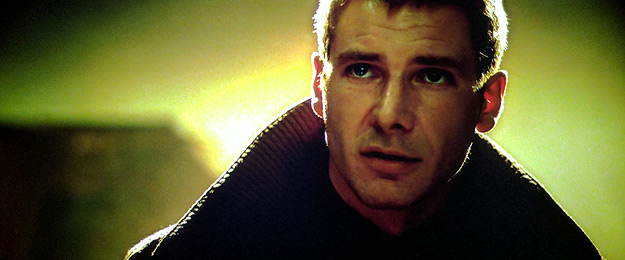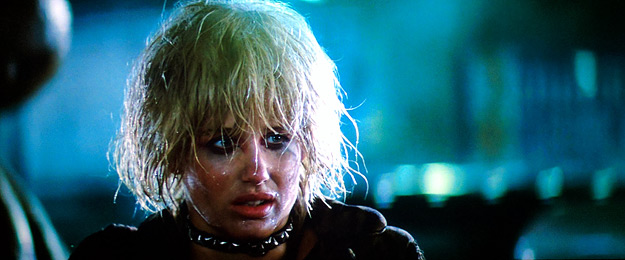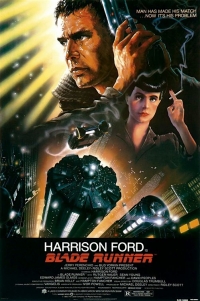THE Q&A
Chris Barsanti is the author of The Sci-Fi Movie Guide: The Universe of Film from Alien to Zardoz (Visible Ink; 2014). His other books include Filmology: A Movie-a-Day Guide (Adams Media; 2010), Handy New York City Answer Book (Visible Ink; 2017), and (with Brian Cogan and Jeff Massey) Monty Python FAQ: All That’s Left to Know about Spam, Grails, Spam, Nudging, Bruces, and Spam (Applause; 2017). He is a member of the National Book Critics Circle, Online Film Critics Society and New York Film Critics Online, and has written for Film Journal International, Film Threat and The Hollywood Reporter.
Charles de Lauzirika produced the Blade Runner: The Final Cut restoration and is the producer-director of Dangerous Days: Making Blade Runner, the exhaustive documentary feature included in the package of value added material on the Blade Runner: The Final Cut DVD and Blu-ray Disc releases. Charles is an acclaimed film documentarian and DVD/Blu-ray producer with over 100 credits, including, in addition to Blade Runner, such essential and award-winning home video box sets as Twin Peaks, Prometheus and the Alien Anthology, along with many other releases including Top Gun, Kingdom of Heaven, and The Martian. He also produced the Star Wars: Launch Bay featurette which debuted at the Disney Parks in 2015. His feature directorial debut, Crave, starring Ron Perlman, was released in 2013, and won multiple awards at festivals around the world.
Paul M. Sammon is the author of Future Noir: The Making of Blade Runner (HarperPrism; 1996; and updated in 2007 and 2017). His other books include The Making of Starship Troopers (Berkley; 1997), Ridley Scott: The Making of His Movies (Close-Up Series; Da Capo; 1999), Alien: The Illustrated Screenplay (Orion; 2000), Aliens: The Illustrated Screenplay (Orion; 2001) and Conan the Phenomenon (Dark Horse; 2013). He has also written for American Cinematographer, Cinefex, Empire and the Los Angeles Times.
The interviews were conducted separately and have been edited into a “roundtable” conversation format.
Michael Coate (The Digital Bits): In what way should Blade Runner be remembered on its 35th anniversary?
Chris Barsanti: The word “visionary” gets thrown around a lot but I think it can be fairly attached to Blade Runner. It’s hard to remember in this day and age of non-stop spectacle filmmaking, what an incredible achievement it was in terms of its special effects and mood, which was arguably as influential on filmmakers as Metropolis and Things to Come. So I would say that it deserves to be remembered as a visionary spectacle that foresaw first a way to make the future look not just bleak in the manner of 1970s science fiction (think Soylent Green) but seductively corrupted, and also how our current filmmakers would mix and match genres (in this case, film noir and science fiction).
Charles de Lauzirika: Even after decades of imitators, bigger budgets and more advanced technology, Blade Runner still stands high as a groundbreaking, unparalleled masterpiece.
Paul M. Sammon: Thirty-five years after its (failed) initial release, I’d like to think that Blade Runner will be remembered as one of the best and most influential science-fiction films of the 20th century — and the 21st.
Coate: What did you think of Blade Runner? Can you recall your reaction to the first time you saw it?
Barsanti: I was probably more impressed with Blade Runner as a teenager than today; it has the kind of overarching grandiloquence that appeals to the adolescent mind. But despite its plot deficiencies, it still exerts a strong pull. I’m always interested in watching it again, which is something I cannot say for nearly any other movie, particularly one directed by Ridley Scott.
Lauzirika: I saw it on opening day at the Mann Hollywood and like many people, I was probably expecting something more along the lines of escapist popcorn entertainment. But also like many people, I left the theater grappling with a far more challenging and deeper artistic experience. But that’s the great thing about Blade Runner after all these years is that it has never stopped luring me into that dark, complicated world. I always get something new out of it.
Sammon: I had been fortunate enough throughout 1981-82 to see various rough cuts and pre-release versions of Blade Runner; therefore, I was the least objective viewer in the theater when I finally witnessed the Theatrical Cut, complete with its uneven narration and tone deaf happy ending, on Blade Runner’s opening day of June 25, 1982. I’d also previously seen a slightly different version during the San Diego sneak preview in May 1982, and had disliked what I considered to be its superfluous, poorly written voiceovers and inappropriate Ride-Into-the-Sunset back then. So I was hoping that those two elements might at least be dropped from the theatrical cut. They were not, and I was. Disappointed, that is. Also, in a certain sense, I guess that by having seen so much of the film prior to its official release, you could say that I was a little burnt out. Especially by the time I ultimately sat down to watch Blade Runner with an opening day audience.
I much more enjoyed being allowed to witness the physical filming, which stimulated my tactile senses along with my visual and auditory ones. Anyone who was on that Ridleyville backlot will remember what an immersive experience it was. The smoke, the endless detailing, the neon, the never-ending swirling rain bars; you literally felt as if you were in Los Angeles circa 2019. It smelled that way too.
Having said all this, it was obvious, even while peering through my haze of Blade Runner exhaustion, that Ridley Scott and Hampton Fancher and Vangelis and everyone else in Blade Runner’s cast and crew had created something utterly unlike anything else in theaters during the summer of 1982. Frankly, Blade Runner was a visual wipeout. Watching Blade Runner during its initial run on a big screen was like being swept away by a pictorial tsunami. And my opinion of the film has actually improved over the decades. Because as I’ve said many, many times, there is more to Blade Runner than meets the eye. Much more.
Pauline Kael, in her dismissive New Yorker review, complained that Blade Runner was all subtext and no text. I can agree with half of that statement, since so many changes were going on during production on both the narrative and the visual level that certain plot strands were ultimately either muddled or lost. But I have to absolutely disagree with Kael on Blade Runner’s subtexts. In my little opinion, it’s exactly those subtexts — such as what it means to be human, how we lead our lives in the face of certain extinction, and whether we as a species will ever acknowledge and reverse the slow suffocation of our environment — which rewards the curious viewer. Blade Runner is also a uniquely hypnotic film. No matter how many times I watch it, by the time Pris walks up to the Bradbury Building and Vangelis’ Blade Runner Blues starts playing, I realize, once again, that I’ve been totally sucked in.

Coate: In what way is Blade Runner significant?
Barsanti: It was possibly the best movie up to that time in terms of creating a living, breathing future world. The way in which it mixed elements of contemporary culture with fragments of the past and predictions about where things were going is now the template for nearly all future-set movies.
Lauzirika: It’s fully, indelibly defined a dystopian vision of tomorrow that all futuristic films after it have been, and will be, compared against. For me, there are three distinct cinematic futures that simply haven’t been topped in terms of world building: Stanley Kubrick’s 2001: A Space Odyssey, David Lynch’s Dune and Ridley Scott’s Blade Runner.
Sammon: It’s been influential on a number of levels. In terms of its hyper-detailing and teeming lived in look, a production design that mixes the old and the new with the familiar and the strange, a graphic sensibility that stands the sophisticated, slightly tongue-in-cheek comic book drawings of Mobius right alongside the realistically engineered extrapolations of visual futurist Syd Mead — well, what you’re left with is a film that’s influenced countless succeeding motion pictures. As well as rock videos, costume designs, even real-world objects like signage and architecture. Furthermore, Blade Runner pointedly touched on themes like overpopulation, mankind’s harm to the natural world, the ethical dimensions of cloning, homelessness, and a whole clutch of other concerns that weren’t exactly on the American radar at the beginning of the Reagan era. All of those themes are still relevant today. So Blade Runner has a pulsing, living life well beyond a movie theater or a home video entertainment center.

Coate: Where does Blade Runner rank among director Ridley Scott’s body of work?
Barsanti: Number one, with a bullet. Nothing else comes close.
Lauzirika: It should come as no surprise that in my opinion, it’s number one.
Sammon: Ranking Blade Runner in Ridley’s canon is a little difficult. Alien seems to have had a broader pop-cultural influence, More people have certainly seen Alien than Blade Runner. And the then-unusual manner in which Alien takes it’s not exactly novel admixture of horror and science-fiction seriously, and weds that to semi realistic characters with near documentary-like performances, and then cocoons its hybrid story line and its somewhat superficial but still believable fictional people within what at the time was a meticulously considered alternate universe, one that pulled in all these different graphic factors while still playing fair with the time-honored rules of cinematic horror and science-fiction and suspense… this was all pretty amazing stuff back in 1979.
On the other hand, I’ve always considered Alien kind of a dry run for Blade Runner. In the way that Blade Runner raises the imagining of Alien’s fictional universe by a whole order of magnitude, while simultaneously crafting a deeper, more challenging set of characters, story elements and emotions. I mean, Alien is essentially a thrill ride, punctuated by some pretty primal, nasty, body-horror elements like the chest burster and the face hugger. But Blade Runner has greater texture, resonance and depth. So I guess purely in terms of weight, Blade Runner tips the scales. I’d put it at number one. Then again, I’m completely prejudiced. That’s why I wrote a book like Future Noir!








